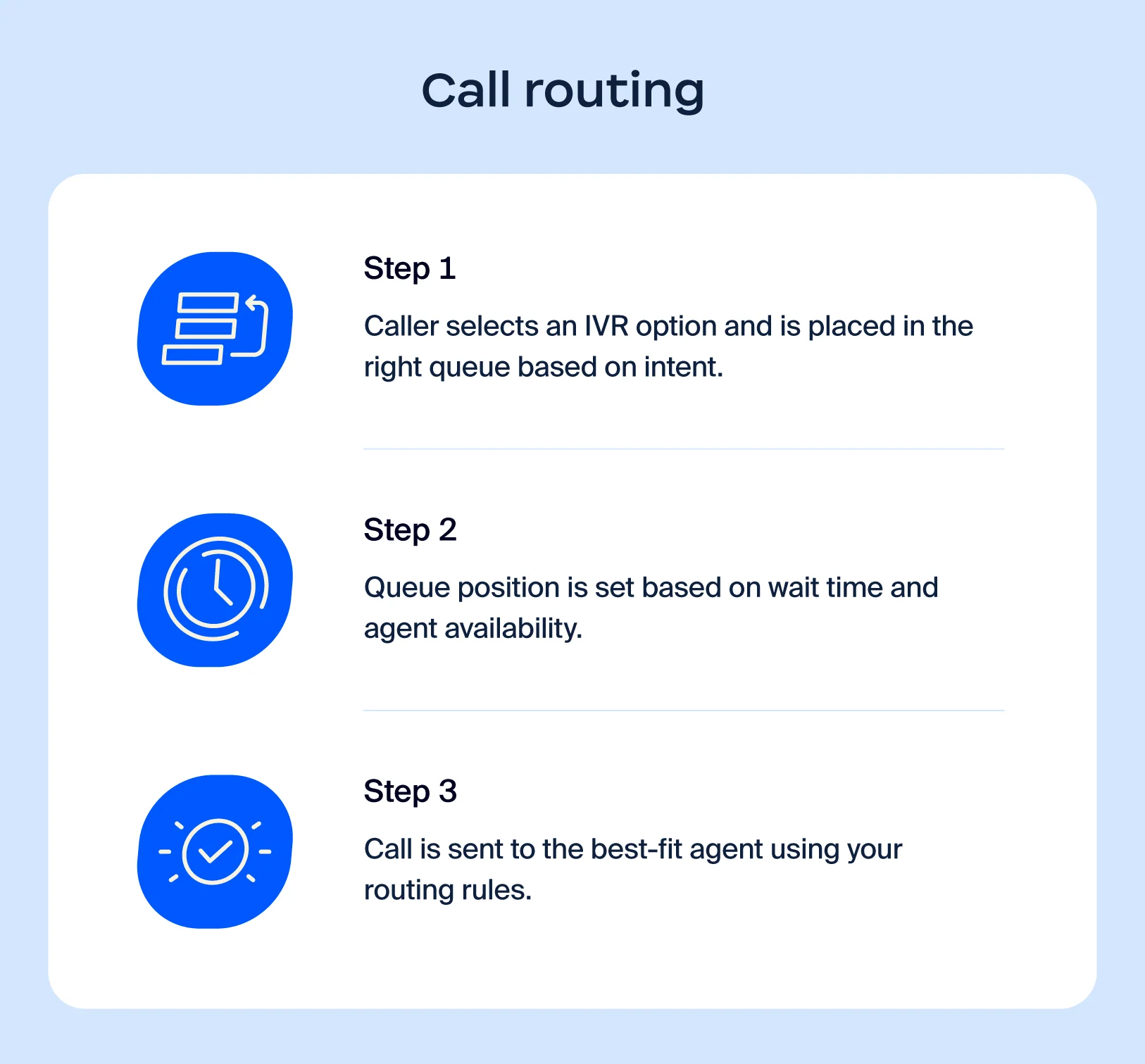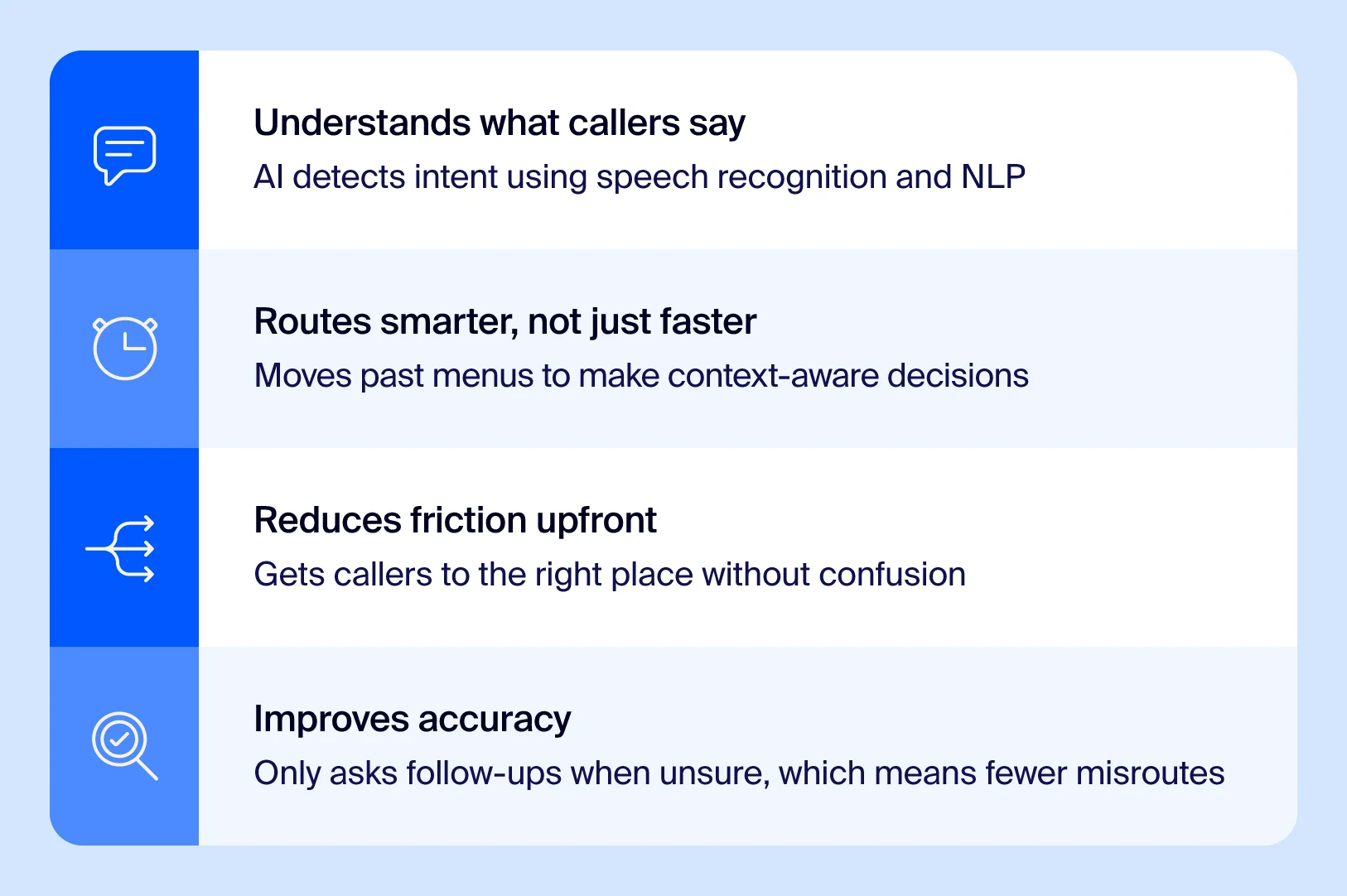
Meet Zoom AI Companion, your new AI assistant!
Boost productivity and team collaboration with Zoom AI Companion, available at no additional cost with eligible paid Zoom plans.
Updated on August 27, 2025
Published on August 27, 2025


Call routing reduces customer wait times, quickly connecting them with someone most qualified to help. Without it, a customer calling about a billing issue might get stuck in a long queue, transferred to the wrong team, and asked to repeat the problem they’re calling about multiple times before reaching the right person. By then, they’re frustrated and more likely to seek services elsewhere.
Today’s call routing systems go beyond simple menus, leveraging data to intelligently connect callers with the most appropriate agent. This approach leads to more efficient interactions and higher customer satisfaction.
In this article, you’ll learn what call routing is, how it works, various call routing types and features, and what benefits it delivers to businesses.
Call routing, also called automated call routing or automatic call distribution (ACD), is the process of sending incoming phone calls to the right person or team. The technology follows rules usually programmed by call center managers or admin leads.
Many companies use interactive voice response (IVR) menus (such as press “1” for sales, “2” for support, and so on) to let callers direct themselves, while others route calls based on factors like the:
Before automated routing, switchboard operators directed each call manually. Today, call routing works automatically through technology, so that companies can connect customers faster and with fewer transfers.
Every inbound call is an opportunity to drive revenue or build stronger relationships with customers and suppliers. Business owners, support leads, and contact center managers extract extra value by connecting every caller to an agent with the right knowledge and experience to move things forward.
The six most significant advantages of call routing are:
For customers, business call routing cuts wait times, reduces transfers between departments, and puts callers in touch with someone who can help them immediately, boosting customer satisfaction. For agents, it reduces stress by shielding them from taking calls they can’t resolve — making their workload more manageable and giving them more time to work on productive assignments.
Call routing systems help improve call center agents’ productivity by connecting callers to the right person more quickly, whether that’s someone with the skills to close a sale, resolve a support issue, or handle a supplier request. If a team member is already on the phone, the system can automatically route the call to an available agent to keep queues moving and balance agent workloads. This system helps teams hit their targets, and callers get more satisfactory outcomes.
Phone call routing gives business owners control over how incoming calls flow through their business. You can route calls by department, skill level, time of day, language, or customer value to the company. For example, billing queries go straight to finance, and your important clients get straight through to senior sales staff. Every caller reaches the right contact the first time.
Automatic call routing helps high-volume businesses stay responsive across multiple teams, departments, and locations. If you run an international firm, you can route calls to the appropriate team based on geographic location and time zone to maintain around-the-clock coverage.
You can also accommodate hybrid working trends by routing calls to staff working from home just as easily as employees in the office. Recent VoIP statistics from the Pew Research Center show that one-third of American workers have a home office setup.
By configuring your IVR system to recognize VIP client numbers or high-intent prospects, you can route them directly to a live agent — skipping the general queue entirely.
This way, your most valuable callers get immediate attention, whether long-term clients needing support or buyers ready to place an order. You can apply similar rules to flag priority calls based on caller ID, CRM data, or call purpose.
Real-time reporting gives managers the data they need to make faster, smarter decisions. With a clear view of call volume, agent activity, and queue performance, optimizing staffing, improving response times, and enhancing overall call center efficiency is easier.
Over time, these insights help teams spot trends, identify gaps, and continuously improve service quality. Let’s have a closer look:
Calls ending in a sale percentage: This metric helps you understand which reps are converting calls into sales and why. Use it to identify top performers, uncover coaching opportunities, and refine your sales strategy based on what’s actually working.
Phone call routing is a key capability of modern contact center software. Think of phone routing as a funnel, directing callers to those who can move the conversation forward. The process has three stages.
During the first step, the contact center software determines the reason for a call based on caller voice prompts or the option a caller selects from the IVR menu — for example, “Press 1 for sales, 2 for accounts,” and so on. It might also be a dedicated number you set up to track responses from an individual marketing campaign.
Once the system identifies the caller’s need, it uses predefined rules to assign them to the right queue. These rules are set up based on factors like issue type, agent skill set, availability, and current wait times — so callers are matched with the best team and spend less time on hold.
The goal is to match the caller to the team that is best equipped to address their needs. The software may take into account factors like current wait times and agent availability to minimize hold times.
The final step is the call distribution phase. Based on your rules, the system routes the call to the most suitable agent. That could be the agent who’s been idle the longest or the next agent on the list. For VIP calls, they might jump the IVR process altogether and go straight through to their account manager.

Routing logic is the rules you give your contact center software to determine where to direct each call. These rules directly affect whether callers reach the right person and how long they wait to speak with someone.
Here are some of the most common routing types with ideal use cases:
Call routing systems offer a wide range of controls for connecting callers to the right person or team. Here are four core call routing features that help you handle inbound calls better:
Admin and managers can set rules and criteria to control how contact centers route and direct incoming calls.
You can connect callers based on department, shift patterns, type of customer, nature of inquiry, and so on. For example, send technical support calls to your product team and billing queries to your finance team so callers get through to the right people faster.
Interactive voice response lets callers choose a department or extension using voice or push-button commands.
Managers can build custom self-service menus allowing callers to connect with a specific team member without speaking to a live operator. As long as the options are straightforward, callers choose the right option, and agents can assist with their requests more quickly.
Intelligent routing allows managers to transfer calls to agents based on their skill set and current workload. If one agent is busy, the system routes the caller to someone else who is capable and available.
When the office is closed, managers can instruct their contact center software to direct callers to voicemail. Zoom AI Companion sorts voicemails by topic or intent and generates a list of tasks based on the messages customers left for the agent.
For high-priority needs, you can route calls to an on-call agent rotation, a follow-the-sun team in another time zone, or guide customers to self-service options through your IVR. This way, urgent issues are addressed promptly without burdening your local team after hours.
Many contact center platforms connect directly to CRM software like Salesforce and HubSpot. For example, there are over 30 CRM integration apps for Zoom CX in the Zoom App Marketplace.
Connecting your CRM to your contact center software lets you:
To prevent bottlenecks, improve agent productivity, and reduce caller frustration, follow these best practice guidelines:
AI is reshaping how contact center software operates. Intent-based routing uses AI technologies like speech recognition and natural language processing (NLP) to understand what callers want. The AI workflow still directs callers based on rules managers set, but can now analyze customer speech and make routing decisions based on their intent. Here’s how it works:

Intent-based routing reduces friction at the first point of contact, helping companies create a faster and more efficient customer journey where callers get the accurate answers they want without waiting.
Zoom Contact Center’s call routing capabilities quickly connect callers to the right team members, enhancing the customer experience with reduced wait times, fewer transfers, and quicker call resolutions.
Plus, call routing can boost your team’s efficiency by getting each call to the agent best equipped to handle it. The platform’s real-time reporting is designed to help you monitor live call flows, and its powerful analytics can help you make more informed staffing decisions.
Request a free demo of Zoom Contact Center to learn how your business can benefit from a cloud contact center solution.